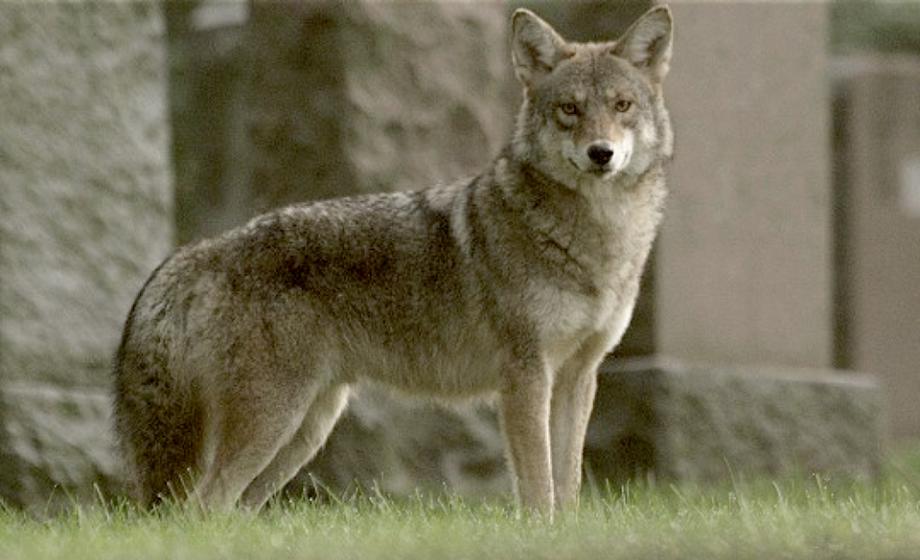Coyote or coywolf: What’s in a name?

The eastern coyote: Considered by some to be “invasive,” the animal — which is generally the size of a medium dog — now can be found in every town in Massachusetts (save Nantucket and Martha’s Vineyard), according to the state Division of Fisheries and Wildlife.
But is it really a coyote?
 Two Clark University researchers say no. Jonathan Way and William Lynn, research scientists with the George Perkins Marsh Institute, are authors of a study in the journal Canid Biology and Conservation urging the renaming of the animal commonly known as the eastern coyote. Instead, they say, it should be named the “coywolf,” a unique species.
Two Clark University researchers say no. Jonathan Way and William Lynn, research scientists with the George Perkins Marsh Institute, are authors of a study in the journal Canid Biology and Conservation urging the renaming of the animal commonly known as the eastern coyote. Instead, they say, it should be named the “coywolf,” a unique species.
Why coywolf? In a blog for The Conversation, Way notes that the animals who roam the Northeast warrant a new species status — Canis oriens — because they are physically and genetically distinct from western coyotes and eastern wolves. The coywolf, Way explains in his blog, is about 60 percent coyote, 30 percent wolf, and 10 percent dog.
Way and Lynn have registered the name Canis oriens (literally, “eastern canid”) with the International Union for the Conservation of Nature, which lists and rates species from across the globe, an action that Lynn says will no doubt spark debate.
The coywolf is a product of hybridization, the result of interbreeding between western coyotes, the Algonquin wolf, gray wolf and other dogs. Western coyotes generally weigh no more than 30 pounds, while wolves can grow up to 90 pounds. Coywolves, however, average 30 to 40 pounds, although 50-pound animals have been found.
But why not just continue to call these creatures “eastern coyotes”? Way writes that while the animals are around 60 percent coyote, they are also 40 percent not coyote. And Lynn, who specializes in ethics and sustainability, notes that the coywolves are just as unique as wolves, which are protected by the Endangered Species Act. The ESA, Lynn says, was written at a time when the emergence of new species through hybridization was not anticipated. With the emergence of a new species like the coywolf, the ESA would require an environmental analysis and appropriate management at the federal level. The same, he says, should be done at the state level.
This story is part of our 7 Continents, 1 Summer series, which highlights the interesting work that Clark students, faculty, alumni and staff are doing all over the world. Have a great story of your own to share? Let us know and we’ll be in touch.
Coywolves, like wolves (and humans), are sentient beings, Lynn explains, and possess self-awareness and social behaviors. They travel in small family units, which likely include two parents, two or three pups, and a few yearlings who help raise the pups. Because people are sentient beings, ethicists like Lynn say we have intrinsic value (that is, a moral value apart from what use someone might have for us).
“Coywolves are, beyond doubt, sentient too,” he says, “and this means that they have intrinsic value as well. So just as there are right and wrong ways to treat other human beings based on their intrinsic value, so too there is right and wrong in how we ought to live with coywolves and other animals.”
While western coyotes thrive in the arid climate of the Southwest, coywolves have adapted to urban and suburban environments in context with human interactions.
Ecologically, coywolves can benefit northeastern communities. Lynn explains that we have created landscapes where herbivores (for example, deer and rabbits) can flourish. These animals can harm vegetation and cause traffic and safety problems. Large predators like coywolves can bring the predator-prey relationship back into balance. Although they are unlikely to take down a large buck, Lynn says coywolves can kill the sick as well as the fawns, which is actually good for the deer herd itself.
In 2007, the Massachusetts Division of Fisheries and Wildlife, responding to hunters’ complaints that coyotes were stealing their game (deer, for example), expanded hunting season on coyotes. Currently, coyote hunting season in the Commonwealth is about five months long, while deer season is just shy of two months.
As an ethicist, Lynn acknowledges that there are times when animals must be killed. However, he says, hunting must be done for justified reasons and in the most humane way possible. “Hunting just for sport is deeply problematic,” he adds.
Coywolves must be respected as predators, Lynn says. When they take easily accessible prey, such as chickens or sheep out of pens, or small pets left unattended in backyards, there is a renewed push to remove them. However, this creates even more potential for conflict.
“Coyotes have small families, and when they’re well-fed, they hold territory and their breeding rate goes down,” he says. “If you remove them, you create open territories. Other coyotes will move in but won’t know the area, so they will go after the easiest food source — unattended pets, dog and cat food left out in yards.” He likens this pattern to what happens with stray cats; removing a colony creates a vacuum effect, leading to the arrival of more cats, who haven’t learned to coexist.
Managing the human relationship with coywolves (and other wildlife that occasionally roams through our backyards) is key, Lynn says. This requires a worldview that animals are members of the more-than-human community, and we ought to learn to live with them so both — and we — can thrive.
There have been very few human-coyote conflicts in Massachusetts, Lynn says. Those that happen generally occur because people allow their pets (or worse, their young children) outside unattended, leave their pets’ food and water out in the open, or even feed the coyotes directly because they don’t understand wild animals and wild animal behavior. In addition, people should avoid coyotes that den in a park or in other places near humans. Once the pups are born, any person who gets too close could be at risk from a parent protecting its young.
“By and large, animals do not intentionally cause problems for people,” Lynn explains. “The number of attacks by wild animal is infinitesimal in North America,” and those incidents most likely were the result of human error or misunderstanding.
“You don’t wait for conflict, then ask someone to kill the animal,” he adds. Rather, he says, you learn how to peacefully coexist alongside such creatures.



